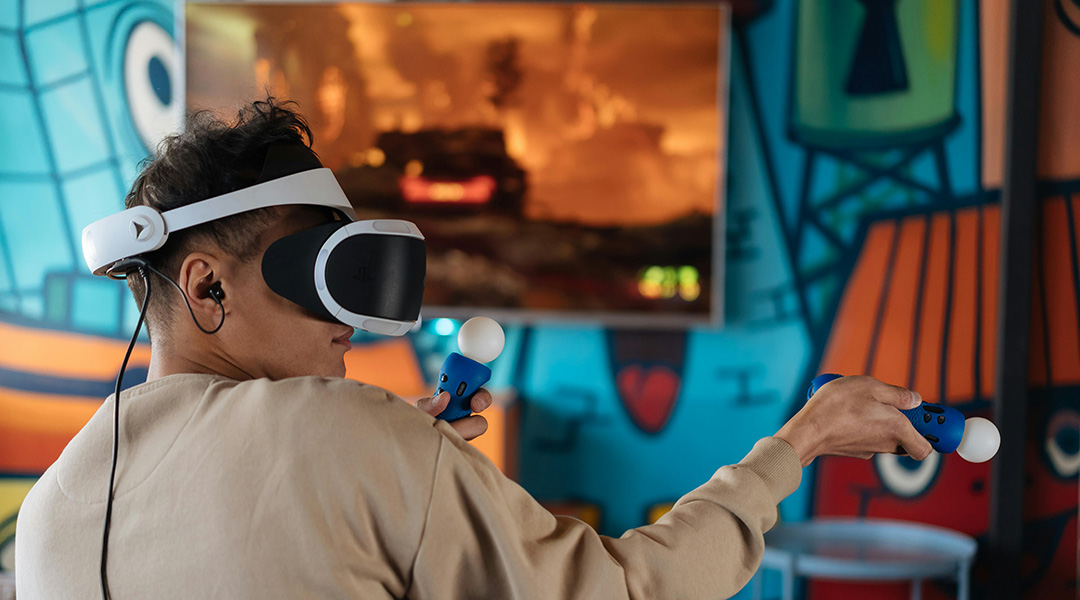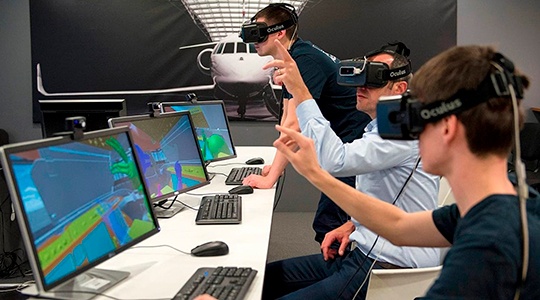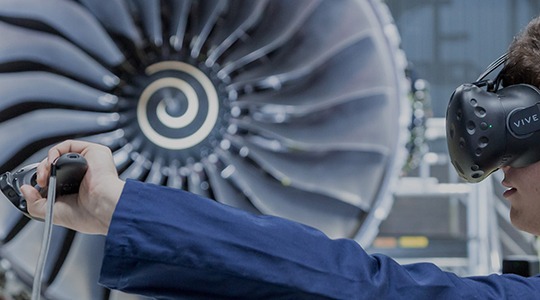In this article, we’ll examine the possible future of virtual reality, some of the biggest trends in VR for this year, make some predictions, and summarize why now is a good time for businesses to start looking for a VR development company that they can partner with.
Examine the current state of the immersive tech market, how this technology is being used for training systems, and what the future holds for it based on current trends and data. Its purpose is to serve as a reference for any company interested in this application of immersive technology.
It would be an understatement to say that the previous 2023 year was huge for virtual reality. First, more than 10.8m virtual reality devices were sold, with estimations indicating that this number would grow up to 23.8m by 2025. Then we had a whole bunch of news stories about world-known brands and corporations jumping into the industry. With such an eventful year, would it surprise you to know that 2024 will be even bigger?
In this article, we’ll examine some of the biggest trends in VR for this year, make some predictions, and summarize why now is a good time for businesses to start looking for a VR development company that they can partner with.
What VR Trends Were Dominant in the Previous Year?
There is a lot of noise and buzz around VR, and we are here to organize the clutter into 5 distinct points that give you a full picture of what is happening in the industry.
1) A rise in enterprise apps
If you thought VR is simply a tool for gaming, this is not true in 2024. Yes, VR is still a dominant force in the gaming industry, but it is also a huge asset for businesses all over the world. The most popular uses of VR within companies involve training, remote collaboration, tests and prototyping, but there are also plenty of creative uses that fall outside these categories. It’s safe to say that thousands of these solutions are in development and the impact of virtual reality will be huge.
2) Greater user adoption
Due to misconceptions about the technology, lack of availability, and pricing, users have historically been hesitant to use and invest in VR. But that has quickly turned around. Today, VR has a reputation as something advanced and cool, and for businesses – highly useful. For example, a survey that asked workers which technologies they would prefer to use at their job noted that the majority looked at immersive tech favorably.
3) Major improvements in hardware
If you have been watching the virtual reality headset market, you’ve probably noticed how the products have been getting cheaper, more powerful, and more convenient to wear. For example, the currently most popular headset (Oculus Quest 2) only costs $299. In 2023, this trend will continue, as products like the “Reality 12K” from Pimax and MeganeX from Panasonic release and shake up the market with their stunning specs. Another notable advancement is the upcoming release of the HTC Vive wrist tracker, since this gadget does not restrict hand movements while providing accurate tracking.
4) Development is easier than ever
It has become incredibly easy for businesses to create VR solutions, and should get even easier in this new year. For one thing, the number of development companies is multiplying year by year, so partnering with a top VR company for app design is quite accessible and prices can be pretty low.
Additionally, the developers themselves can work faster and better because the premiere tools they use (Unity and Unreal engines) are rolling out key new features for VR. For instance, Unreal Engine 5 has rolled out support for OpenXR, a standard for developing applications for multiple VR platforms simultaneously. Thus, a company will be able to use various headsets with the same software solution.
5) More VR-tailored services
We’ve talked a bit about how VR is helping businesses improve their internal processes, but it’s also important to mention how it is helping them make money. In particular, a whole new market of VR services for consumers and businesses is opening up, with pioneers in this field gaining the opportunity to massively profit. One of these pioneers is the fitness firm Liteboxer, which is providing a professional boxing simulator in VR as a premium service.

VR Trends of 2024: More is Yet to Come
1. Immersive educational experiences
In 2024, education transformation stands as one of the most notable VR trends. Virtual reality shatters traditional learning boundaries as classrooms are transported to different epochs or even other planets. It's as if history, geography, and science lessons have come alive, fostering more engagement and better comprehension. The possibility of performing complex surgical procedures in a risk-free, virtual environment is a massive leap for medical training. In essence, the future of VR points towards reshaping our entire approach to education and training.
2. The advent of hyper-realistic virtual reality
Hyper-realism is another virtual reality trend that's caught everyone's attention. In 2024, the line between virtual and reality blurs as technological advancements enable VR experiences to mimic real-world physical sensations. Whether it's the feel of raindrops on your skin, the smell of a summer meadow, or the taste of a virtual feast, sensory virtual reality elevates immersion to unprecedented levels. With this, we are heading towards a virtual reality future where the distinction between what's real and what's not might be hard to tell.
3. Expansion of social VR platforms
The future of virtual reality isn't just about individual experiences anymore. The rise of social VR platforms is one of the most exciting trends in virtual reality. People cannot only interact with each other in real-time within a virtual environment, but they can also host parties, attend concerts, and participate in multiplayer games. These platforms are becoming more user-friendly, diverse, and community-focused, paving the way for a more inclusive and social virtual reality future.
4. Integration of AI in virtual reality
Artificial intelligence is increasingly intertwined with VR, creating a more personalized and intuitive user experience. AI-powered VR experiences analyze user behavior and preferences, subsequently adapting the virtual environment to individual needs. The integration of AI is, therefore, instrumental in creating a dynamic and responsive virtual world, marking a significant shift in the future of virtual reality.
5. Adoption of VR in the business world
Finally, the VR revolution has yet to leave untouched the corporate world. Companies leverage virtual reality for various purposes — from prototyping and design to staff training and customer service. This trend highlights the versatility of VR beyond gaming and entertainment, and it's only the beginning. As the technology becomes more affordable and accessible, we can expect an even greater adoption in the business sector, further emphasizing the importance of virtual reality future trends.
6. Virtual Reality Revised with Apple Vision Pro
The Apple Vision Pro, launching in 2024, reimagines virtual reality by integrating high-resolution displays and user-centric design, ensuring unparalleled immersion. It emphasizes ergonomic wearability and introduces interactive AR overlays, broadening applications in education, gaming, and professional simulations. Enhanced connectivity features promise seamless integration with existing Apple ecosystems, setting a new standard for VR engagement and interactivity.
In summary, the VR trends of 2024 point to a paradigm shift in the way we interact with digital content. As it stands today, virtual reality is far from a simple amusement tool. It's an immersive, transformative, and social technology reshaping industries and how we perceive reality. From education and entertainment to business and social interactions, VR permeates various facets of our lives.
Looking ahead, the virtual reality future is unquestionably revolutionary. While the current trends hint at what's possible, the ultimate potential of virtual reality remains vast and largely untapped, encouraging us to anticipate what's next in this thrilling digital adventure.
Metaverse: the big VR story of 2024
While our list of trends paints a comprehensive picture of what is going on in the industry, there is one trend we left out, which deserves a much closer look — the metaverse. In July 2021, CEO of Facebook Mark Zuckerberg announced the creation of the metaverse, following suit to rename his company to Meta. In the months that followed, dozens of major brands (like Microsoft, Disney, Tencent) also announced their entry into this metaverse.
The metaverse is a remarkable digital universe accessed via virtual reality, allowing you to mirror many activities from your daily life into a virtual domain. Unlike traditional VR applications, which operate as independent entities, the metaverse weaves all applications and services together, providing a seamless, uninterrupted experience. This fascinating phenomenon is shaping up to be one of the defining VR trends of our time.
Although conceptually introduced in 2021, the metaverse is poised to flourish and develop its unique shape in 2024. In one sphere, we have Meta, collaborating with a multitude of companies to forge a singular, global metaverse. Concurrently, countless other businesses are delving into this concept, constructing their personalized metaverse — a comprehensive ecosystem of interconnected VR applications intended for their unique enterprise needs.
Our findings show that one of the immediate advantages discovered in the metaverse is amplified collaboration. The future of VR here manifests in the form of digital avatars, enabling users to engage in a more authentic manner. This digital reality is also an exceptional platform for data visualization, assisting in exploring intricate subjects and objects.
The trends in virtual reality, notably in the context of the metaverse, show how well it simulates diverse work and life scenarios. This isn't just the stuff of sci-fi anymore; it's becoming a practical tool for visualizing products or services in a way that wasn't previously possible.
In essence, the metaverse is not just a playground. It's a multifaceted digital universe that's shaping virtual reality future trends. It's a space where work, learning, and play converge in a unique blend of reality and imagination. With the metaverse at its helm, the future of virtual reality is poised to redefine our interaction with digital environments, paving the way for a future where the virtual is as significant and influential as the physical.
Thus, the rise of the metaverse is the embodiment of the future of virtual reality, and as we move forward, we can only anticipate the new ways in which this digital landscape will evolve and transform our perception of what's possible in the virtual world.

Virtual Reality Uses in the Future: Who It Benefits
While we have a solid understanding of the short-term trajectory and future of virtual reality, based on recent advancements and industry trends, the long-term future of virtual reality remains a captivating mystery filled with immense potential. If we project 10-15 years into the future, we can formulate some predictions about the evolution and application of VR technology.
A seamless blend of real and virtual worlds
The trends in virtual reality suggest a future where the boundary between the real and virtual worlds will be almost indistinguishable. The advent of hyper-realistic VR experiences we are witnessing today will likely mature into a standard feature, leading to a wholly immersive and interactive virtual reality future. Virtual environments will not only simulate our physical reality visually but also engage all our senses, creating a more profound and authentic experience.
Ubiquitous use in various industries
As VR continues to evolve, its application will likely extend to virtually all sectors. We can expect to see an expansion in the use of VR beyond gaming and entertainment into areas like education, healthcare, retail, real estate, and more. The future of VR in these industries will likely involve more immersive training programs, virtual tours, product demonstrations, and therapeutic treatments, among other applications.
Enhanced social interactions
The social aspects of VR platforms are likely to become more prominent in the future. Virtual reality trends suggest that we'll see more interactive social VR platforms, enabling users to engage in collaborative projects, participate in shared experiences, and build communities within the virtual world. It's not unrealistic to predict that significant life events might be celebrated in these virtual spaces, further blurring the lines between physical and virtual interactions.
Greater integration of AI and VR
Artificial Intelligence (AI) is poised to play a more integral role in shaping the future of VR. AI algorithms can tailor virtual experiences to individual users, creating a personalized and intuitive VR environment. The combination of AI and VR could usher in a new era of dynamic, responsive, and adaptive virtual realities.
Evolution of the metaverse
Looking into the far future of virtual reality, the evolution of the Metaverse stands out. This interconnected virtual world will likely become more sophisticated, hosting a myriad of applications and services in one seamless and uninterrupted experience. The Metaverse could become a central hub for work, play, and social interaction in the virtual realm, significantly impacting how we live, learn, and connect.
Full-body motion tracking
For now, virtual reality apps mostly track the movements of our heads and possibly hands (if controllers or gloves are used). In the future, we could see full-body tracking with users wearing a special suit or just attaching some sensors to their clothes. This should be very handy in safety training (e.g. working with heavy equipment) since VR simulators will not only analyze users’ knowledge, but also the precision of their movements.
Immersive movies
In the distant future, we could see virtual reality headsets and glasses replace or substitute TV sets and movie theaters. People will be able to get the entertainment they want right in front of their eyes without the need to go anywhere or invest in a giant screen for their home.
The entertainment industry could contribute to this trend by making movies more immersive. They might let people see events unfold from more than one angle, and perhaps influence character choices. Netflix already experimented with this format (although not in VR) with their Bandersnatch movie.
Smart personal assistants
Virtual assistants are already helping us in our phones (e.g. Siri, “Ok Google”), but VR could really evolve them. These assistants will take on a human-ish form and act much more. If people wear VR glasses, these helpers could accompany them through their daily tasks and activities. The implications of this are huge for all industries: if the AI is sufficiently advanced, these programs could provide knowledge, perform customer service, and even help monitor the quality of work.
Playpens for physical activity
One of the current limiting factors of virtual reality is that apps must be designed for very careful and limited user movement (you don’t want the user to move too much due to unseen hazards). However, 10 years from now, everyone could have a playpen where they use VR and also physically move around – run, crouch, jump, etc. without any risk to their health. This would be huge for the gaming and fitness industry, which will jump at the chance to provide a much more engaging experience to their clients.
How Is VR Already Used in 2024?
As we delve into the world of VR in 2024, let's explore how virtual reality is already being used in various sectors, transforming traditional operations and paving the way for unprecedented possibilities.
Education and training

In the world of education and training, the future of virtual reality has already arrived. Schools and universities worldwide are leveraging virtual reality trends to provide immersive learning experiences. From exploring the pyramids of Egypt in history class to observing the solar system in physics, VR is transforming classrooms into dynamic learning environments. Additionally, industries such as healthcare are using VR for training. Surgeons can practice complex procedures in a risk-free, virtual environment, enhancing their skills and reducing the risk of medical errors.
Entertainment and gaming
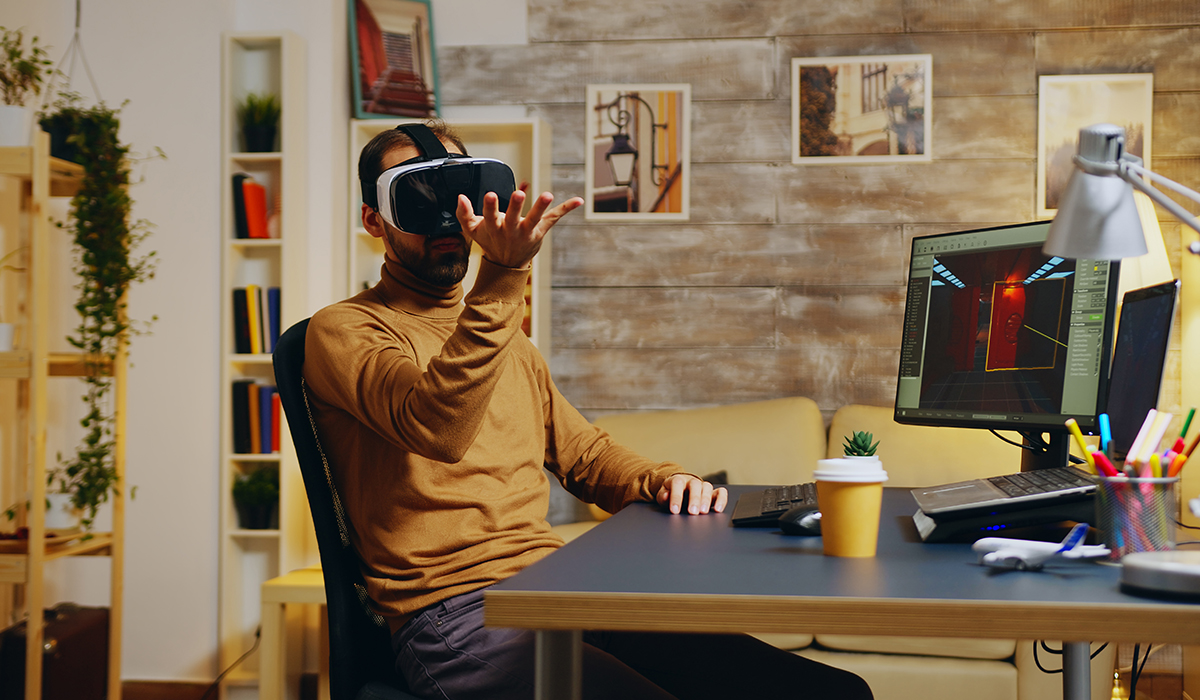
In the entertainment sector, VR's influence has been transformative. From virtual concerts and art galleries to hyper-realistic video games, VR is revolutionizing the way we consume entertainment. It provides immersive experiences that transport users to different worlds, making them active participants rather than passive viewers. As one of the most significant VR trends, the entertainment and gaming industry continues to innovate, promising even more captivating experiences in the future.
Business and industry

As we step into the future of virtual reality, corporate landscapes are undergoing a radical transformation. Architects, leveraging VR trends, are now crafting intricate 3D blueprints of their projects, breathing life into structures before the first brick is laid. Simultaneously, automotive engineers employ VR to conduct meticulous virtual crash analyses, contributing to safer, more robust vehicles.
But the ripples of VR's influence don't stop there. The real estate industry is harnessing VR's potential to offer prospective buyers immersive property tours, effectively transcending geographical barriers. In the retail sector, the traditional try-before-you-buy experience is receiving a virtual makeover. Customers can now don outfits in virtual dressing rooms, redefining shopping experiences.
Clearly, VR's versatility is making it an invaluable asset across various professions, heralding an exciting era in business innovation. The future of VR is here, and it's reshaping our professional world in ways we could only have dreamed of just a few years ago.
Social interaction and collaboration

The use of VR for social interaction and collaboration is one of the most exciting trends in virtual reality. Social virtual reality platforms provide users with digital avatars and the ability to interact in real time within a virtual environment. These platforms are not just about socializing; they also offer opportunities for collaborative work, networking, and community building. From attending a virtual conference to hosting a virtual party, social VR platforms are providing new ways for people to connect and collaborate.
Healthcare and therapy
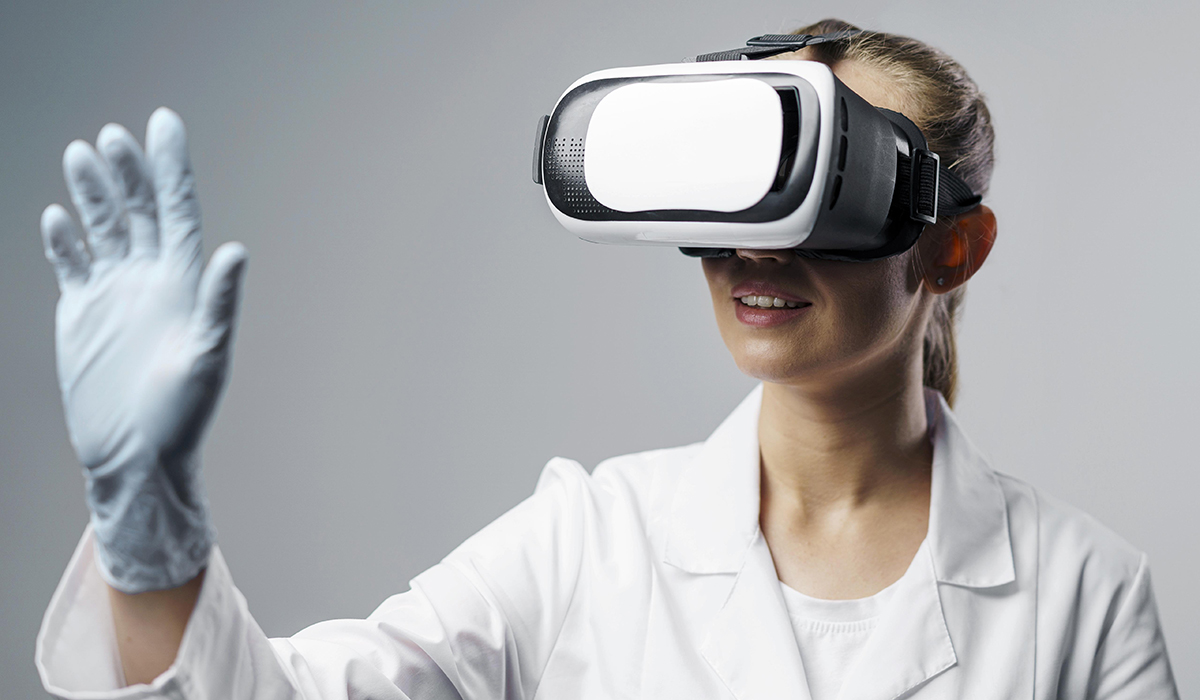
The integration of VR into healthcare is another notable application in 2024. Beyond training, VR is being used for patient treatment and therapy. For example, it's being used to help treat phobias and post-traumatic stress disorder (PTSD) by gradually exposing patients to their fears in a controlled environment. In physical therapy, VR games are helping patients regain mobility and improve coordination in a fun and engaging way.
The metaverse

The metaverse, a term that has gained significant traction in 2023, is a fully immersive, interconnected digital universe. Users can seamlessly transition between different activities without having to leave the Metaverse. They can attend a virtual meeting, visit a digital art gallery, or participate in a multiplayer game - all within the same virtual space. The metaverse is poised to become a central hub for entertainment, work, and social interaction in the digital realm.
Therefore, VR is already making waves in 2024, with its applications spanning various sectors. The potential of virtual reality is vast and exciting, and we are just beginning to scratch the surface. As technology advances, we can anticipate even more innovative uses for VR, further blurring the lines between the physical and virtual worlds.
The current use of VR is merely a glimpse into this technology's potential. As we continue to explore and push the boundaries of what's possible, we get closer to a future where virtual reality is an integral part of our everyday lives.
How to Mount this Wave of VR Boom?
As we ride the crest of the VR wave in 2024, it's essential to understand how to harness the power of these virtual reality trends. Here are some strategies to help you successfully navigate and capitalize on this VR boom.
1. Embrace immersive learning opportunities.
Leverage the future of VR in education by adopting immersive learning tools. Whether you are an educator, a student, or a professional seeking continued training, immersive educational experiences can provide a competitive edge. Virtual simulations and interactive lessons help to increase understanding and retention.
In medical training, for example, VR can simulate complex procedures, offering risk-free practice. By capitalizing on this trend, we can revolutionize learning and development, making it more engaging and effective. Therefore, virtual reality is quite a flexible technology.
2. Invest in hyper-realistic VR experiences
If you are a content creator, developer, or entrepreneur, investing in hyper-realistic VR experiences could be a game-changer. The future of virtual reality is increasingly leaning towards multisensory experiences. It's not just about what users can see; it's about what they can touch, smell, and even taste.
The more realistic the virtual world, the more immersive and captivating the experience for the user. These hyper-realistic experiences could set you apart from the competition and create a loyal user base.
3. Engage in social VR platforms
As an individual or a business, engaging with social VR platforms could open up a world of opportunities. These platforms provide new ways to interact, network, and collaborate in the virtual space. The future of VR is social; it's about building communities, attending virtual events, and even hosting virtual meetings. These virtual reality platforms are becoming more user-friendly and inclusive, making them a valuable tool for both personal and professional growth.
4. Integrate AI into your VR strategy
Artificial Intelligence (AI) is becoming a crucial component of VR. Integrating AI into your VR strategy can create a more personalized and dynamic user experience. AI can adapt the VR environment based on user behavior and preferences, making the experience more engaging and intuitive. Whether you are a developer or a business owner, leveraging AI in your VR solutions could lead to higher user satisfaction and retention.
5. Leverage VR for business applications
The corporate world is just beginning to tap into the potential of VR. Companies use virtual reality for diverse purposes - from product design and prototyping to staff training and customer service. If you are a business owner, consider how VR could streamline your operations or enhance your customer experience. The possibilities are endless, and early adoption could give you a significant advantage in your industry.
6. Explore the metaverse
The Metaverse is one of the most exciting trends in virtual reality today. This interconnected virtual world provides a seamless and uninterrupted experience, hosting multiple applications and services. As a developer, creating VR apps for the Metaverse could be a lucrative venture. As a user, the Metaverse offers new ways to work, play, and interact in the virtual realm.
Understanding the virtual reality trends of 2024 is a crucial starting point. It's akin to having a roadmap to navigate the rapidly evolving landscape of VR. The trends highlight the areas of growth and the potential avenues for innovation. They provide insight into consumer behavior and preferences, offering a glimpse into the future of VR. As the VR landscape continues to expand and diversify, these trends will serve as an invaluable guide for anyone venturing into this realm.
Adaptability is another essential factor when it comes to virtual reality. In the ever-evolving world of technology, flexibility is key. The VR industry is no exception. From the advent of standalone VR headsets to the introduction of the Metaverse, the VR landscape is constantly shifting. Being open to new technologies, ideas, and possibilities can help you stay ahead of the curve and maximize the opportunities that arise.
Contact us to steer the potential of virtual reality.
Having a vision for the future of virtual reality is equally important. It's about looking beyond the current trends and imagining the possibilities. What could the future of virtual reality look like? How can we leverage VR to create more immersive, interactive, and meaningful experiences? By envisioning the future, we can start to shape it today.
The transformative power of VR is already being felt across various sectors. From education and healthcare to entertainment and business, VR is revolutionizing the way we learn, work, and play. It's creating new opportunities for interaction, collaboration, and innovation. As we embrace these trends and harness the power of VR, we become active participants in shaping the future of virtual reality.
Whether you are a user exploring virtual worlds, a developer creating immersive experiences, or a business owner leveraging VR for your operations, now is the perfect time to dive into VR. The potential of virtual reality is vast and largely untapped. It's an exciting journey of discovery and innovation, bound only by the limits of our imagination. Let's navigate this digital landscape together and shape the future of VR.
Now is the time to invest in VR
We’ve given you just a small taste of the future of VR for businesses, so what will your course of action be – stick to familiar technologies and existing solutions, or innovate and provide your clients/employees something more with virtual reality? A custom VR/metaverse app can work wonders for your business and establish your company as a pioneer in its respective field.
As a result of our tests, we determined that if you make the choice to build a VR app (or at least analyze how feasible it is), your first step should be to contact a reliable partner. For example, Program-Ace has been creating immersive apps for over 7 years, and our work has been recognized and praised by such respected agencies & organizations as Clutch, IAOP, and Goodfirms.
Our team is ready to build a custom solution that meets your business needs and incorporates even the most complex functionality. This might be a standalone training app, some kind of product simulator, or anything else you put your mind to. We can even aid in the creation of your metaverse. To learn more about our experience and past work, be sure to check out our portfolio.
To learn more about what we offer and how we can help, be sure to send us a message about your project.

